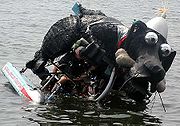
Pontoon effect
Encyclopedia

Pontoon (boat)
A pontoon is a flotation device with buoyancy sufficient to float itself as well as a heavy load. A pontoon boat is a flattish boat that relies on pontoons to float. Pontoons may be used on boats, rafts, barges, docks, floatplanes or seaplanes. Pontoons may support a platform, creating a raft. A...
to capsize
Capsize
Capsizing is an act of tipping over a boat or ship to disable it. The act of reversing a capsized vessel is called righting.If a capsized vessel has sufficient flotation to prevent sinking, it may recover on its own if the stability is such that it is not stable inverted...
without warning when a lateral force is applied. The effect can be sudden and dramatic because the vessel is stable and self-righting as greater lateral force is applied, up to the point that the pontoon(s) on one side of the vessel are completely submerged. At this point, stability suddenly disappears and the vessel rapidly capsizes.
(The same term can also arise when describing a design in which the attributes of a pontoon are created without using explicit pontoons—when a design effectively incorporates pontoons. This page describes the specific phenomenon described above.)
The pontoon effect is theoretically possible whenever the vessel's entire weight exceeds the buoyancy of the pontoon(s) on either side. However, the pontoon effect is much more likely in vessels with a high center of gravity
Center of gravity
In physics, a center of gravity of a material body is a point that may be used for a summary description of gravitational interactions. In a uniform gravitational field, the center of mass serves as the center of gravity...
and low or non-existent displacement
Displacement (fluid)
In fluid mechanics, displacement occurs when an object is immersed in a fluid, pushing it out of the way and taking its place. The volume of the fluid displaced can then be measured, as in the illustration, and from this the volume of the immersed object can be deduced .An object that sinks...
other than the pontoons.
A pontoon vessel such as a catamaran
Catamaran
A catamaran is a type of multihulled boat or ship consisting of two hulls, or vakas, joined by some structure, the most basic being a frame, formed of akas...
floats in a level position when the center of gravity of the entire vessel (including its load) is above the center of buoyancy. This is the opposite of the case in a traditional or displacement hull vessel, which derives positive stability from having its center of buoyancy above the center of gravity. If the pontoon vessel tips, it will remain stable as long as the center of gravity does not move further to the side than the center of buoyancy is moved by the change in the depth (and displacement) of each pontoon. Under these conditions a "righting force" (a turning moment
Moment (physics)
In physics, the term moment can refer to many different concepts:*Moment of force is the tendency of a force to twist or rotate an object; see the article torque for details. This is an important, basic concept in engineering and physics. A moment is valued mathematically as the product of the...
) acts on the vessel to push it back toward the level position.
However if the center of gravity is high relative to the width of the vessel, and the pontoons on one side are unable to bear the vessel's complete weight, the lateral movement of the center of buoyancy will be restricted. Even a relatively small lateral force can move the center of gravity further to the side than the center of buoyancy can go. At this point, the righting force will disappear, replaced by a turning moment in the opposite direction. This can capsize the vessel at the point at which one pontoon is completely submerged.
When using twin lateral pontoons, each pontoon should have enough buoyancy to bear the load of the entire vessel on its own. If the vessel is so heavy that either pontoon is mostly submerged when no lateral force is applied, it will be vulnerable to the pontoon effect. If sufficient lateral force arises (such as wind or shifting load), the vessel can tip enough to submerge one pontoon. At this point, the sunken pontoon will provide no further buoyancy to right the vessel. As the center of buoyancy cannot move further to that side to match the center of gravity, that pontoon will continue sinking. The tipping angle will increase until the vessel capsizes. This can continue until the vessel inverts completely with the pontoons again floating on the surface but the rest of the vessel underwater. At this point, the upside-down vessel will be highly stable. If, on the other hand, the vessel is designed and loaded so that each pontoon can support the vessel's entire weight (plus any lateral forces that arise like wind), the center of gravity cannot move transversely beyond the center of buoyancy at the most extreme tipping angle, and the pontoon effect cannot occur.
In the abstract sense, the principles at work govern the stability of all boats and ships including those without lateral pontoons. See angle of loll
Angle of loll
Angle of loll is a term used to describe the state of a ship which is unstable when upright and therefore takes on an angle of heel to either port or starboard....
and metacentric height
Metacentric height
The metacentric height is a measurement of the static stability of a floating body. It is calculated as the distance between the centre of gravity of a ship and its metacentre . A larger metacentric height implies greater stability against overturning...
.

